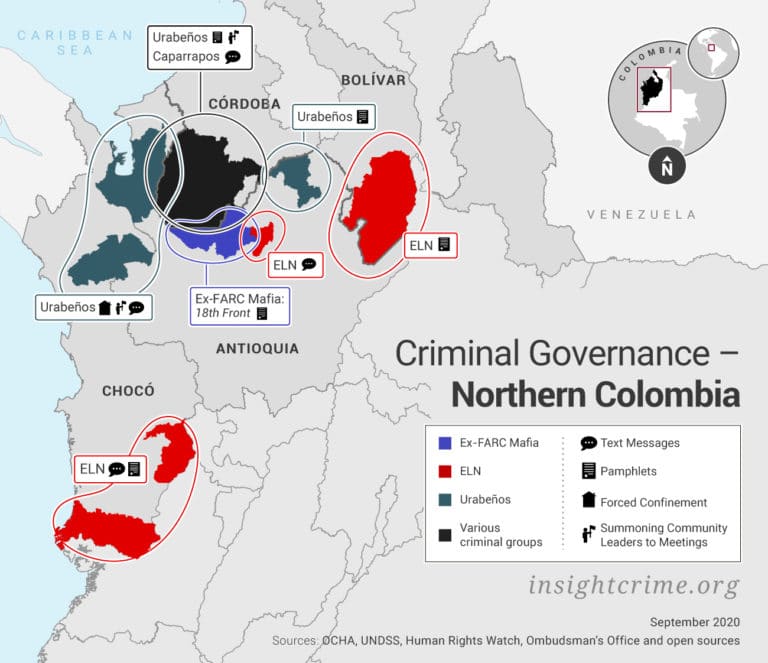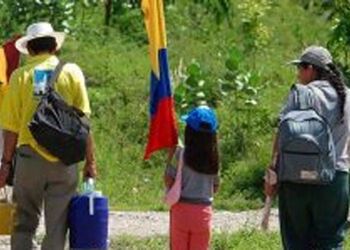The pandemic has done nothing to reduce clashes between criminal actors in Colombia, with a rise in violence in early 2021 causing the number of people fleeing their homes to skyrocket.
Between January and March 2021, displacements in Colombia increased by 101 percent compared with the same period in 2020, the United Nations Office for the Coordination of Humanitarian Affairs (OCHA) warned in its June 2021 report.
Of those displaced, 80 percent fled due to threats from criminal groups or outbreaks of violence, accounting for 29,252 displaced people, mostly in Colombia’s Pacific region and the Western departments of Nariño, Antioquia and Cauca.
Only a fraction of those displaced – 5,415 people in total – had been able to return home by June 2021.
While Colombia is home to a growing number of criminal groups, the OCHA report showed that the country’s three largest are mostly responsible for the displacements, namely the National Liberation Army (Ejército de Liberación Nacional – ELN), the Gaitanista Self-Defense Forces of Colombia (Autodefensas Gaitanistas de Colombia – AGC), also known as the Urabeños, and a range of dissident groups once belonging to the former Revolutionary Armed Forces of Colombia (Fuerzas Armadas Revolucionarias de Colombia – FARC).
InSight Crime Analysis
Residents of Colombia’s most at-risk areas are paying the price for the adaptability shown by the country’s criminal groups during the COVID-19 pandemic.
Security forces have been distracted by a COVID-19 crisis that has pummeled the country in waves. While displacements doubled between January and March 2021, clashes between criminal actors and authorities dwindled.
Security operations against armed groups dropped by 48 percent between January and April, while reports of violence between criminal actors increased by 44 percent, according to a report by the Ideas for Peace Foundation think tank (Fundación Ideas para la Paz – FIP).
SEE ALSO: Criminal Governance Under Coronavirus: How Colombian Groups Seized the Day
And why were Nariño, Cauca and Antioquia the most violent departments? In a 2019 review of displacements in Colombia by InSight Crime, these three departments already accounted for three of the top four departments with the most people fleeing their homes. The motives have only worsened.
In Antioquia, seven community displacements had already occurred in different areas of the department by March. In total, more than 4,000 people left municipalities such as Ituango, Amalfi, Peque and Murindo due to armed confrontations between the ELN and Urabeños, RCN reported.

Nariño, on Colombia’s southern border with Ecuador, has been in serious conflict due to the former FARC factions, ELN and Urabeños all fighting for control. But in early 2021, the dissident FARC groups have increasingly turned on each other.
Violence between the FARC’s dissident 30th Front and an alliance of FARC and Urabeños groups has made the situation all the more volatile.
To the north of Nariño, in Cauca, FARC dissident cells and the ELN are fighting over coca. The eternal attempts to control cocaine trafficking has seen a worrying escalation of brutal old war tactics, such as anti-personnel mines. Out of fear of falling victim to these explosive devices, dozens of families have fled the municipality of Argelia, one of Cauca’s violence hotspots. In Caloto, another municipality in Cauca, 500 people abandoned their homes due to clashes.
While mobility restrictions have only recently been lifted in many parts of Colombia, it appears that criminal groups have ignored those restrictions and quarantine measures for months. As they have tried to recover economic losses resulting from the pandemic, Colombians caught in the crossfire have been forced to leave their homes in the midst of a complicated health crisis in order to save their lives.


